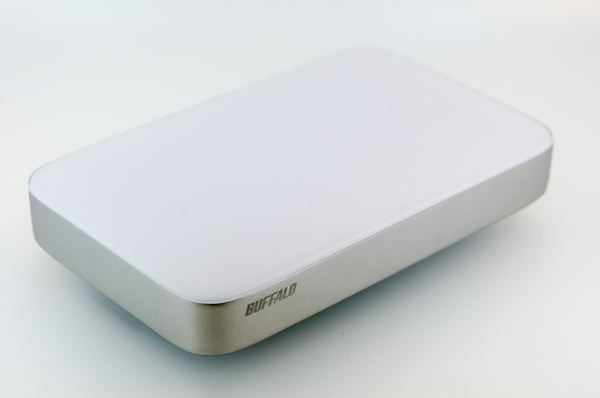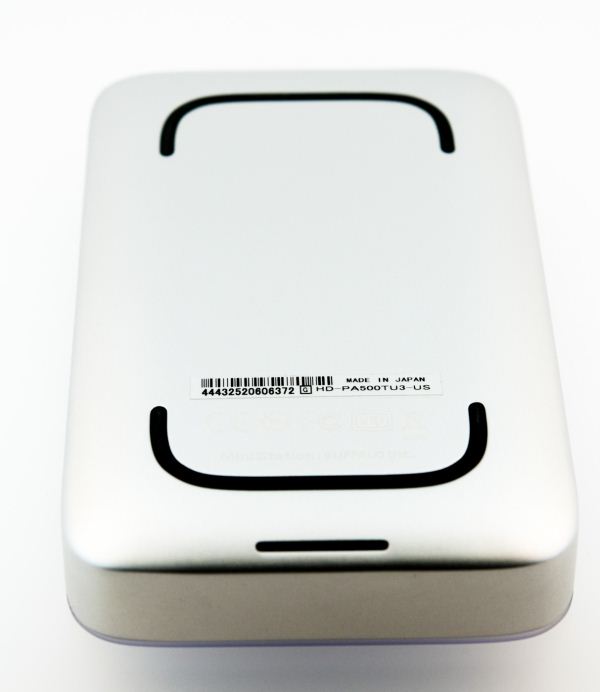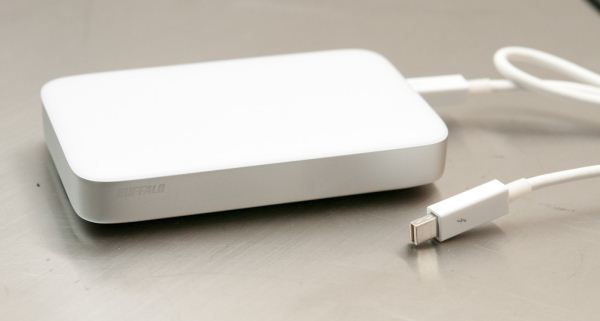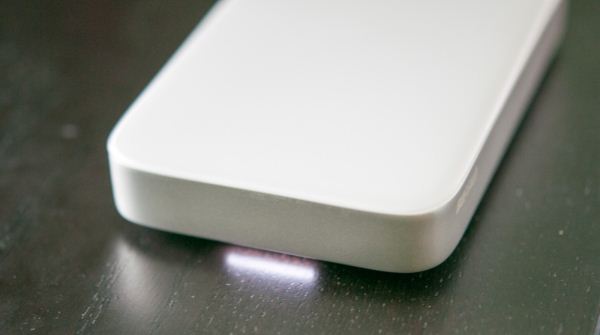Buffalo MiniStation Thunderbolt Review - An External with USB 3.0 and Thunderbolt
by Brian Klug on August 1, 2012 4:04 PM EST- Posted in
- Storage
- SSDs
- USB 3.0
- Thunderbolt
- Buffalo
Back when Thunderbolt (then Intel Lightpeak) was optical, I was actively involved in covering the interface, partly out of professional curiosity due to my optical background, partly because I sincerely believe optical interfaces are an inevitable part of the future. When Lightpeak became Thunderbolt and lost the optical layer, it fell under Anand’s beat and the Mac umbrella. I acquired a MacBook Pro with Thunderbolt somewhere around the same time, but never acquired any Thunderbolt peripherals or drives. Since then, Thunderbolt has slowly but surely gained traction with more and more peripherals and host devices. Initial adoption was glacial in part because most of the earliest Thunderbolt peripherals were really aimed at the very high end market with big RAID or JBOD stations, and partly due to what boiled down to Thunderbolt being Apple-only until just recently.
There’s an interesting story as to exactly why most of the initial Thunderbolt peripherals were aimed at such a high-end market, and some of it was purely because of both the TDP, size, and engineering constraints involved with the first generation Thunderbolt controllers. The other half of the equation is that selling external storage isn’t always the most valuable prospect, as shoppers expect commodity pricing and generally know the cost of the drive inside. Thankfully, second generation Thunderbolt controllers with smaller size, TDP, and lower cost are now the norm, and at the same time Apple has unleashed more Macs with the interface of note, meaning that there’s a bigger captive market of potentially interested shoppers.
So when Buffalo dropped us a line about an upcoming 2.5" form factor portable hard drive with both USB 3.0 and Thunderbolt interfaces, I couldn’t resist the temptation and jumped at the opportunity to review it. When it comes to single drive external Thunderbolt storage, the only real options at this point are either the Seagate GoFlex, or the new Buffalo MiniStation Thunderbolt.
The Buffalo MiniStation comes in two flavors, differentiated only in storage size. There’s a 1 TB version which runs $229.99 named the HD-PA1.0TU3, and a 500 GB version named the HD-PA500TU3 and priced at $199.99. The only difference is what drive you get inside; both include Thunderbolt and USB 3.0. Buffalo has also opted to include both the USB 3.0 and Thunderbolt cables with both MiniStations. Prior drives required the separate purchase of a Thunderbolt cable, which costs around $50. Since there are now multiple cable suppliers (whether this means the active controller in the cable, or companies cabling the system remains unknown to me), pricing has started creeping down and Buffalo was able to include both a 19.7 inch Thunderbolt cable and USB 3.0 cable.
| Buffalo MiniStation Thunderbolt | |||||
| HD-PA500TU3 | HD-PA1.0TU3 | ||||
| Storage | 500 GB HDD | 1 TB HDD | |||
| Interface | miniUSB 3.0 (2.0 legacy), Thunderbolt (no pass through), Cables Included | ||||
| Formatting | Mac (HFS+) | ||||
| Size, Mass | 3.17 x 5.12 x 0.91 (inches), 9.28 oz | ||||
| Pricing | $199.99 (newegg) | $229.99 (newegg) | |||
Since Thunderbolt is still predominantly an Apple interface (7-series boards and IVB Ultrabooks notwithstanding), the industrial design of the Buffalo MiniStation is decidedly Apple inspired. The drive is made of two main parts, a single piece aluminum can in which the drive sits, and a plastic top which snaps inside this assembly.
There’s a series of white status LEDs which shine through a diffuse rectangular chicklet cutout on the bottom front lip, which reflects up off of a surface. The indicator light breathes like an Apple power indicator when there’s activity, and stays solid when plugged in. It’s a nice take on an external hard disk status LED that I haven’t seen done before.
On the underside are two small rubber feet which actually aren’t part of the aluminum base but make contact with the drive caddy inside. Regulatory markings are laser etched near the front rubber foot. At the back of course are the Thunderbolt and USB 3.0 ports, on opposite sides of the drive.
Construction of the MiniStation is subjectively great. There’s not much flex if you squeeze the aluminum side against the plastic lip, and it feels like a solid brick of aluminum in the hand. I’ve regularly transferred videos shot on my DSLR onto the MiniStation, then tossed the drive into the main pocket of my backpack. It isn’t a super rugged design, but definitely will get the job done.





















61 Comments
View All Comments
Graham. - Thursday, August 2, 2012 - link
Because USB 3.0 isn't all it's cracked up to be. It's already too slow to handle the data that a modern SATA III SSD can throw at it, let alone a multi-SSD RAID. This is where Thunderbolt really shines.AnnonymousCoward - Thursday, August 2, 2012 - link
No, sudokill has a valid question. USB3 can do up to 400MB/s throughput. The comparison did use unique SW and OS's.ssj3gohan - Thursday, August 2, 2012 - link
There is just absolutely no point to this product. It is freakishly expensive for what it does in what has become a commodity market. The design decisions that make it expensive are idiotic. Thunderbolt is a couple tens of percent faster than USB 3, but this drive doesn't even come close to saturating any interface. There is just no point.Also, it is clearly not aimed at disassembling and putting something inside that actually does benefit from the TB interface. It's cumbersome to disassemble and the device is (at least optically) internally damaged when doing so.
Who the hell thought of this and more importantly: why could Anandtech ever say it is 'an affordable price point'? Yes, it is affordable compared to a TB-carrying computer, but it's way too expensive to even consider when buying external storage (and after all, this is nothing more than external storage). It's more expensive than equally performing *wireless* hard drives! It's more expensive than buying a TB to USB 3.0 cable and any other commodity external hard drive. It's more expensive than buying a low-end NAS!
Talking about a high-margin market...
philipma1957 - Thursday, August 2, 2012 - link
Okay seagate's t-bolt adapter is 99 the cable is 50 and a usb 3 adapter is 20 so 169 gives you the ability to use 2 drives since you have a pair of adapters . so for 169 I have an endless choice of drives and the ability to use 2 of them.Of course I need to pay for drives.
this way I have a case with a slow 500gb hdd . And I have 2 ways to connect it. seems to me a lot of people would go for the seagate choice over this.
repoman27 - Thursday, August 2, 2012 - link
What driver and transfer mode was used for the USB 3.0 tests? Were you using the Windows 7 driver? The numbers would seem to indicate BOT was being used. If so, was the maximum payload size the default 64 KB? Does this device support UASP?This product really does seem to fall pretty far off of the price/performance curve. Surprisingly, there are some Thunderbolt products that aren't bad at all when you plot the cost per GB versus straight-line speed. Notably, the Western Digital My Book Thunderbolt Duo 6TB which Newegg was listing for $579.99 the other day (10.5¢/GB for 240MB/s speeds), and the Promise Pegasus R6 12TB which offers insane speeds, flexibility and good construction for less than 20 cents per GB.
This is yet another product that can only be rationalized for use with a 2011 model Mac. Every other PC with Thunderbolt also has USB 3.0, so why would you pay a premium for Thunderbolt in this case? The USB 3.0 only version of this drive is only $89.99 on Newegg right now. That's a $140 or 155% price increase for a feature that would only pay dividends on a 2011 Mac.
mattlach - Thursday, August 2, 2012 - link
I will always prefer eSATA to Thunderbolt for storage, as eSATA is native.Graham. - Thursday, August 2, 2012 - link
You don't understand. The beauty of Thunderbolt is that it is completely 'native'. Connecting a Thunderbolt drive is like connecting the drive directly to a SATA port on the motherboard. Or, in the case of a multi-bay RAID like the Pegasus it's like connecting to a hardware RAID card in to a PCIe slot. All over a single cable with no decrease in speed or added latency!mattlach - Friday, August 3, 2012 - link
Oh,That seems like it could have some neat usage scenarios then. Seems a little pricey for a simple external hard drive though, as now you'd need a separate controller in the portable unit, whereas with eSATA you are using the controller you already have on your machine.
mattlach - Friday, August 3, 2012 - link
Still think I would have prefered a further development of the Expresscard standard shrinking its size and making more PCIe lanes directly available, rather than the development of something new requiring new changes to operating systems and drivers to ensure compatibility.I wonder how long until Thunderbolt is properly supported under Linux.
Also, I have a strong distaste for proprietary formats.
munsie - Monday, August 13, 2012 - link
Even better -- since Thunderbolt looks like PCIe to the host OS, most devices just work, even under legacy OSes that were released before Thunderbolt. As long as their was already a device driver available for whatever PCIe chip is in the device, it should just work. The only thing that might not work right away is hotswap support. Since Thunderbolt devices can be plugged in and removed at any time while most machines treat PCIe as only swappable between reboots, you might have to reboot your machine if it's running an older OS.Thunderbolt and ExpressCard have more in common that you think -- both appear to the host OS as PCIe devices for the most part.
Also -- how is Thunderbolt any more proprietary than anything else? It's currently only offered by Intel, but I suspect we'll see more vendors offering chips at some point soon. Most are probably taking a wait and see approach.